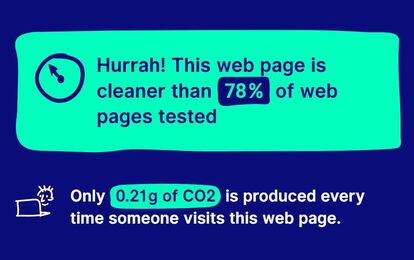The environmental impact of your website is surprising
By: RubberDuck Team
June 19 2023
The carbon footprint of your business website may seem inconsequential, but it’s not. Although there is strong awareness regarding this issue among companies worldwide, particularly in Europe, it is a topic that is rarely addressed in America.
Until recently, our perception was that utilizing the internet and digital tools had positive environmental implications. Reading newspapers online saved paper, naturally, while streaming music meant a decline in plastic CDs production. But those tangible resources that are not polluting your neighborhood dumping ground anymore have been effectively replaced by more intangible data streams that still produces tons of CO2 everyday but that you cannot see.
What part of a website produces CO2?
The production of CO2 emissions primarily comes from the energy consumption of the data centers and servers hosting the website, as well as the transmission of data over the internet.
In short, every interaction of someone or something with your website results in electricity being used, thus CO2 emissions being produced. When someone visits your website, their browser needs to send a message to your server requesting access to your content. Your server then responds to this request and return the necessary keys to unlock that content and display it. This happens often, every time someone (or something) performs an action of any sort such as clicking a button, filling a form, or switching page, and your server uses a small amount of energy to complete that task every time. Of course, the energy needed to complete this task is very small, but it adds up fast when you consider all the interactions!
And the more complex your website is, the more energy it requires to process data, the more CO2 it produces. Even the colors you choose for your website has a significant impact on his carbon footprint since some colors, like tones of red, use much more energy to display than blue for example. In fact, selecting a black background color for your website instead of a white one will require 70% less energy to display on your visitor’s device using an LED screen.
For an average small business’ websites, each page view produces 0.5 grams to 5.0 grams of CO2. For a website with 10,000 monthly page views, that's 60 kg to 600 kg of CO2 produced every year!
For a website with 10,000 page views monthly, 60 to 600 kg of CO2 are produced each year!
What is my website’s carbon footprint?
Fortunately, website owners can find on the web several calculators to assess their environmental impact. A good calculator typically considers factors such as the website's traffic, hosting infrastructure, and user behavior to provide an estimate of CO2 emissions. It takes inputs such as average monthly page views, hosting provider, and server location to estimate the carbon footprint of a website.
Of course, we were curious to see how a typical RubberDuck website would fare since we worked hard to lighten our templates as much as possible.
We found out that a RubberDuck website produce 70% less CO2 emission than the average website.

How can you reduce your website’s carbon footprint?
Reducing your website's carbon footprint can be achieve by making some conscious and significant choices when building your website:
• Choose a green website builder such as RubberDuck or a green web hosting provider.
• Optimize website performance in terms of loading time.
• Minimize overall website size and complexity.
• Enable GZIP Compression and implement Content Delivery Networks (CDNs).
• Optimize Images and minimize third-party scripts.
• Emphasize Sustainable Design and choose energy-effective colors.
By implementing these measures, you can significantly reduce your website's carbon footprint and contribute to a more sustainable digital environment.
RubberDuck has made it his mission to provide a website builder that prioritize the creation of websites with the lowest carbon footprint possible.
As more and more businesses around the world commits to become sustainable, carbon neutral organizations, the demand for sustainable digital solutions and experts is growing rapidly.
RubberDuck recognizes the urgent need for sustainable digital solutions and has made it his mission to provide a website builder that prioritize the creation of websites with the lowest carbon footprint possible. By incorporating energy-efficient practices, optimizing code, minimizing resource-heavy elements, and utilizing renewable energy sources, RubberDuck aims to revolutionize the website development industry.

